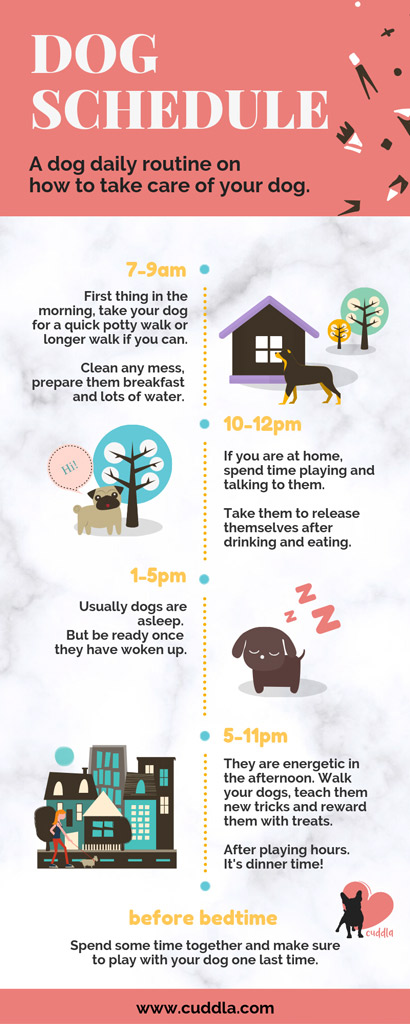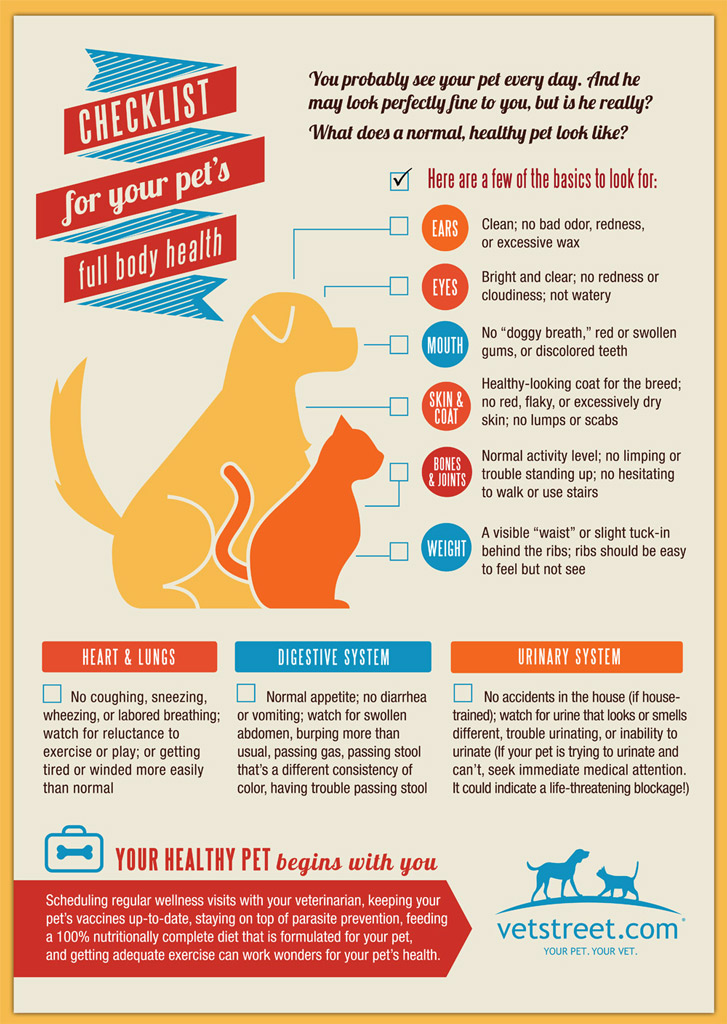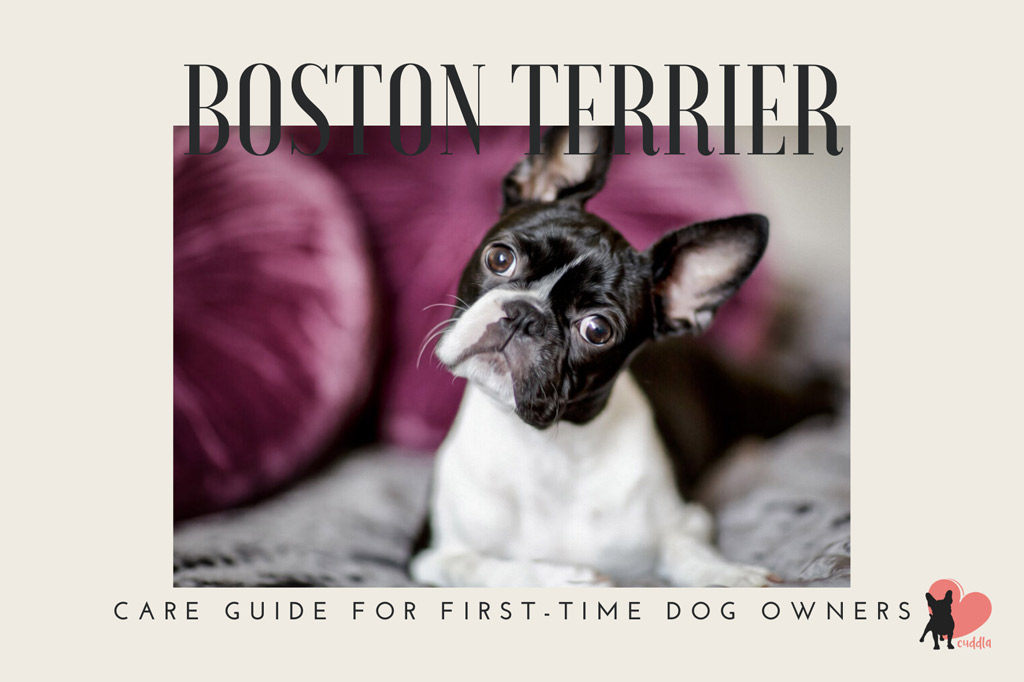
A healthy Boston Terrier lives longer and happier! And as dog parents, that’s all we want.
In today’s fast-paced world and busy lifestyle, it’s easy to get lost with so much advice or fall behind on the promises you once committed to as a dog parent (one common challenge here is that you lack time).
This happens more often than you or I would like to admit; no one is perfect.
That’s why I wrote this beginner’s guide, so you can get a complete picture about how to care for a Boston Terrier.
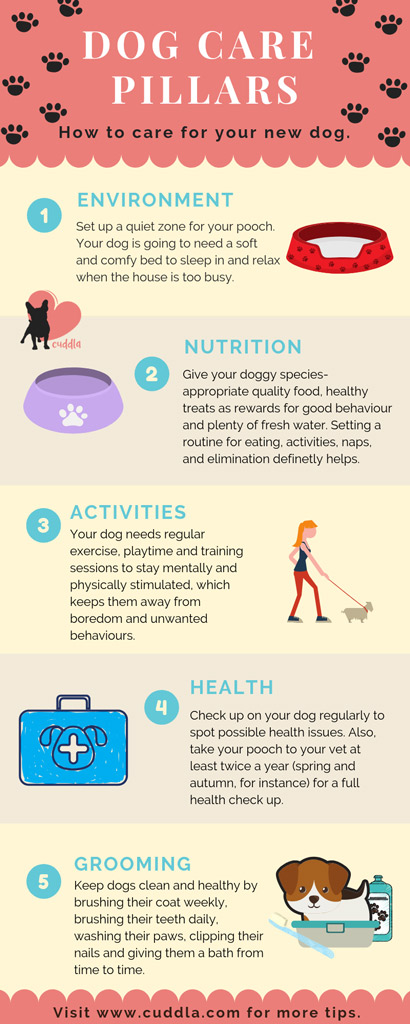
How to Care for a Boston Terrier
My experience and research have taught me that it’s very important to know and cater to a dog’s need.
So, when caring for a Boston Terrier, I will be addressing their 5 basic needs:
- Environment.
- Nutrition.
- Activities.
- Health.
- Grooming.
These 5 points meet the dog’s welfare needs, which are included in The Animal Welfare Act.
#1 – Boston Terrier Environment
Believe it or not, your dog’s environment plays an important role in dog care. But, what does this actually mean or look like?
- A dog-friendly home (dog-proof house and garden for your Boston’s safety and comfort).
- A dog safe zone (your dog’s own space, a dog room).
- Companionship (spending quality time with your Boston Terrier).
A Dog-Friendly Home
Dogs have the right to a safe environment that is free from hazards and dangers.
So, it’s time to dog-proof your house and garden! Here’s how:
Before your new pooch arrives at your home, one of the first things to do is go through your house and identify any possible hazards. Then with that, you can start considering where your doggy is going to be spending most of the time.
The easiest way to dog-proof your home is to go through this room-by-room checklist:
- Kitchen:
- Use childproof latches to keep cabinets closed.
- Place medications and cleaning products out of reach.
- Keep trash cans closed or inside a latched cabinet.
- Keep foods out of reach.
Depending on your home plan, you might want to keep the door closed or install a dog gate to keep the kitchen inaccessible at times, especially when you or someone else (an adult preferably) isn’t there.
- Bathrooms:
- Keep laundry basket and cabinets closed.
- Place cleaning products out of reach.
- Maintain a closed bin policy.
- Keep the toilet lid closed to prevent drowning or drinking of harmful cleaning chemicals.
Keep the bathroom doors closed at all times, especially when you’re not in there, to limit your dog’s access since there’s no need for your pooch to be in there alone.
- Living room:
- Place dangling wires from lamps, VCRs, televisions, stereos, and telephones out of reach. Hide them behind furniture.
- Move any poisonous house plants out of reach. Careful with hanging plants, dogs are resourceful and can jump onto them from a nearby surface.
- Make sure all heating and air vents have covers.
- Put away anything that could be dangerous or breakable.
- Be careful with your curtains, as they attract pet hair, dander, and odours. Wood blinds or vertical blinds are a great alternative.
Since this is the main room of the house, as a rule of thumb always tidy up toys after playing. This rule applies to both your dog and your kids. This is also the simplest solution to avoid confusion and to avoid hazards.
- Bedrooms:
- Keep clothes and shoes behind closed doors.
- Place lotions and cosmetics off accessible surfaces like the nightstand.
- Move electrical and phone wires out of reach of chewing.
Unless your dog sleeps in your room, bedrooms can be another off-limits space for your pooch.
- Hallway:
- Avoid open stairways, decks or balconies, which can result in falls. You can put gates on the stairs.
- Keep doors closed, especially if they can allow your dog to escape outside.
- Hide all the cables.
If you’re planning to install a dog door, the hall entry is a great place to put it to restrict your dog from the rest of the house, especially if you have multiple floors.
- Garden:
- Make sure that plants in your garden are safe for dogs.
- Have a fence that is at least 24-inches tall.
- Check the fence for any holes or spaces where your dog might be able to squeeze through and patch them up.
- Keep your swimming pool or pond fenced or covered.
- Have a secure lock on your garden gate so your pooch cannot freely or easily open.
- Keep gardening tools and products hidden and out of reach.
- Ensure that garbage bins are closed and if possible, keep them behind closed doors.
- Garage and shed:
- Move all chemicals to high shelves or behind securely closed doors.
- Clean all antifreeze from the floor and driveway.
- Keep all sharp objects and tools out of reach.
Finally, get familiar with toxic products for your pooch that you find at home.
- Toxic products for dogs:
- Some plants.
- A selection of human foods.
- Medications.
- Household cleaning products.
- Air fresheners.
- Candles.
- Plant fertilizers.
- Antifreeze.
- Etc.
Read also: How to Make Your Home Dog-Friendly and How to Make Your Garden Dog-Friendly blog posts.
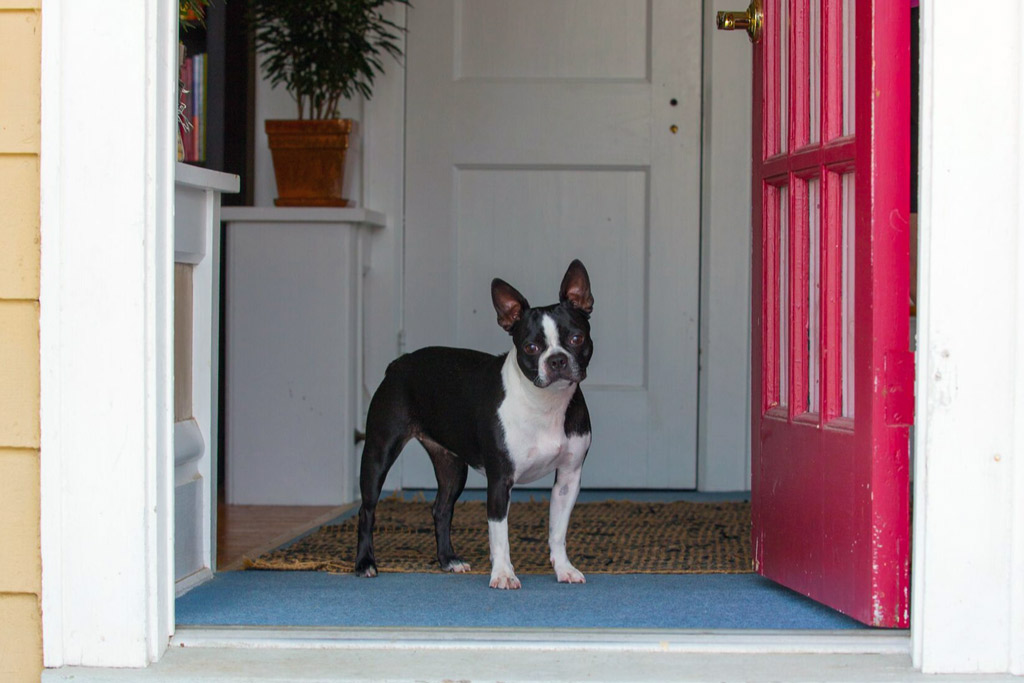
A Dog Safe Zone
Once your home is dog-proof and dog-friendly, there’s one last thing you can do to make it comfortable for your dog.
A dog safe zone isn’t hard to create, but it does require some thought.
First of all, decide where you have room to create a permanent area just for your dog. It should be a place that your pooch has free access to since the goal is that he sees it as the BEST PLACE ever!
Think of it as an extended space of your dog’s sleeping area.
That’s why you should choose a quieter area of your house. Your furry friend will go to his dog-safe zone when he needs to rest or if he’s feeling nervous.
Next step is to make it comfortable. So, what does your pooch need?
- A bed: Dogs spend more than half of the day sleeping, so your pooch needs a comfortable bed!
- A blanket: Ideal for burrowing and extra warmth.
- A crate: If you want to crate train as part of house-training your puppy.
- A playpen: They come in handy when you live in a small apartment or/and open-plan space.
- A dog-gate: Very useful to limit your dog’s access to the rest of the house and to keep him in a restricted area when alone.
- Toys: Interactive toys help with your dog’s mental stimulation and some plush toys provide emotional comfort.
- A feeding bowl: Establish a feeding area in your dog’s safe space where you can place your dog’s bowls for food and water.
- A water bowl: Keep water accessible at all times and change your dog’s water daily to keep it fresh and clean.
Also, establish a feeding area where you are going to be placing your Boston Terrier’s bowls for food and water.
You probably want to remove the food bowl after your doggy finishes eating, so you have some control over the feeding schedule. But, always keep a water bowl around a corner so your furry friend always has fresh water available.
For ideas on what you can get, my Dog Safe Zone Kit list on Amazon shows you a list of dog beds and other basic necessities you should have for your pooch.
The last step is to introduce your Boston pup to his space and gradually teach him that it is okay to stay there by himself.
Read also: How to Create a Dog Safe Zone for Your Pooch to Relax.
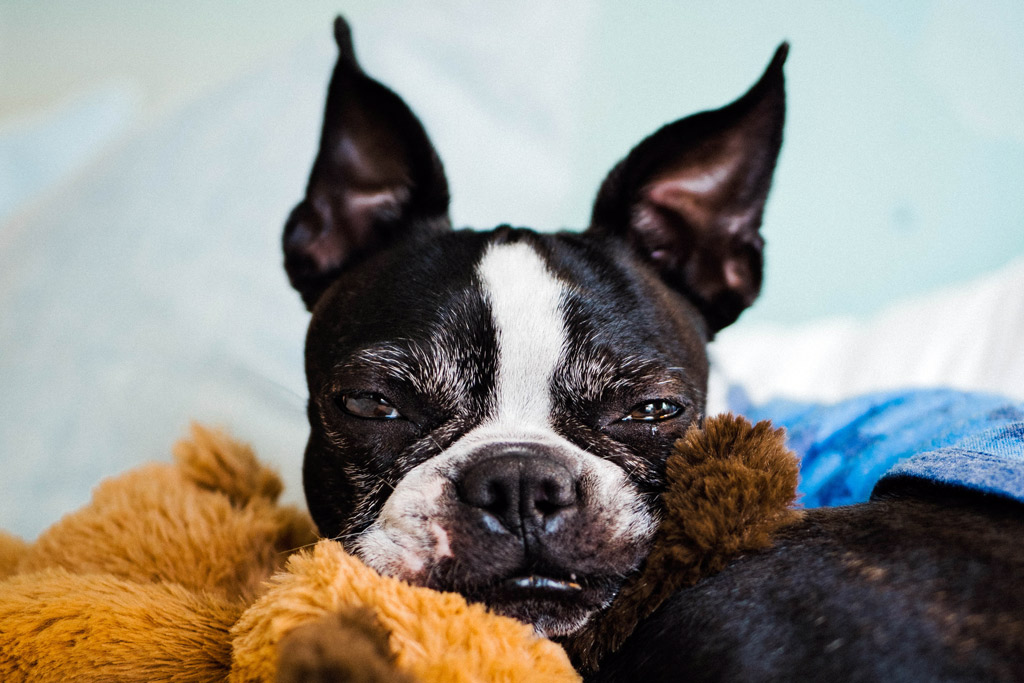
Companionship
Dogs, like us, are social creatures and need company. Not only that, but they also enjoy and value human companions.
Your Boston Terrier needs companionship and to spend quality time with you daily. Bostons are companionship dogs after all!
Although cuddle time might come naturally to some people, dogs need us to spend quality time with them:
- Exercising.
- Playing.
- Training.
- And, of course, petting them!
Spending time with your pooch is another responsibility for dog owners and this opens up the question of how leaving your pooch alone at home for too long affects them…
According to PSDA, the maximum amount that you should leave your dog alone is 4 hours.
There’s no dog that enjoys being left alone. Some are able to handle the alone time better than others, but that doesn’t mean that they like it. Boston Terriers can develop separation anxiety when left alone long hours and often. It’s important to gradually teach your pup that staying alone for a while is okay.
Read also: Can a Boston Terrier Be Left Alone? For How Long?
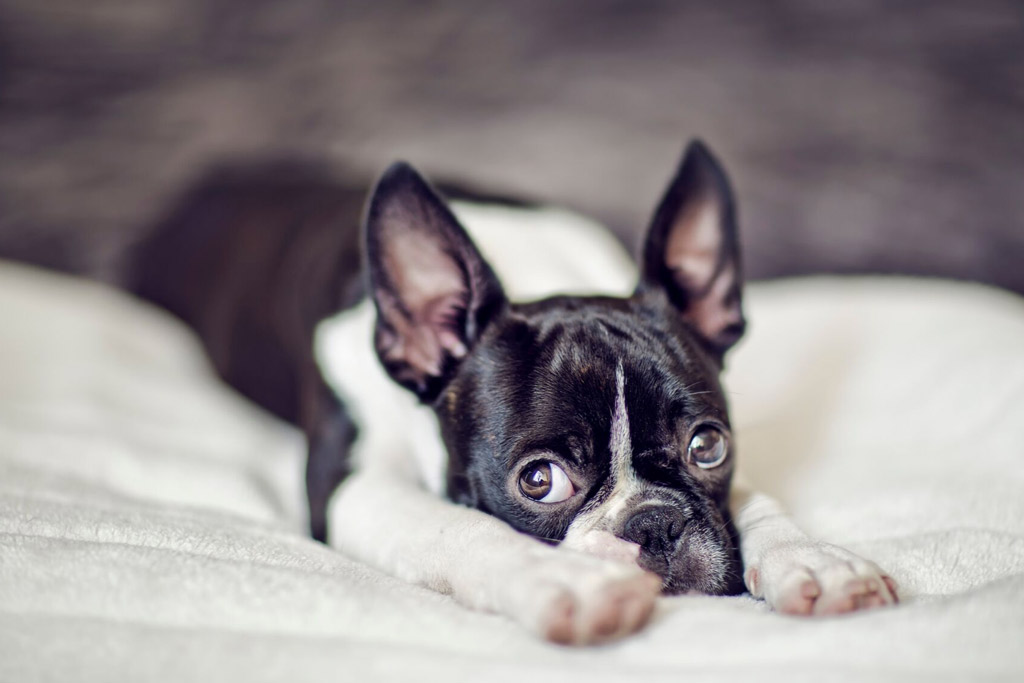
#2 – Boston Terrier Nutrition
Boston Terriers should eat a species-appropriate balanced diet to make sure your dog gets all the nutrients needed for a healthy and long life.
When determining the right diet for your Boston Terrier, consider the following factors:
- Age.
- Size.
- Metabolism.
- Activity level.
Boston Terriers are small-breed dogs that have a fast metabolism with high energy needs. However, depending on their life stage (puppy, adult or senior dog), they need to consume different food quantity.
Generally, adult Bostons eat two meals per day, while puppies should consume between three to four meals. This means that you divide their daily food quantity in “x” number of meals.
Essential Nutrients
Before thinking of what to give your dog to eat, let’s look at what nutrients dogs need in their diet to be healthy.
Whether you buy your dog food or make it yourself, your Boston needs a balanced diet which is species-appropriate to stay healthy. This kind of diet includes a mix of:
- Proteins.
- Fats.
- Vitamins.
- Minerals.
- Water.
A Balanced and Species-Appropriate Diet
A species-appropriate balanced diet for a Boston Terrier will include:
- High-quality protein: Lean-muscle meats, fish and eggs.
- Moderate level of animal fat: Salmon and sardines.
- High levels of EPA and DHA: Omega-3 from krill oil.
- A few fresh cut veggies: Broccoli and kale (mimics prey’s stomach contents).
- No grains.
- No potatoes or other starches.
Plus, your furry friend should be well hydrated.
Food Choices
Once knowing what nutrients your dog needs to stay healthy, the next step is to choose what types of foods you will feed your pooch.
There are five types of food that you can give your pooch:
In the commercial or processed dog food category:
- Kibble.
- Canned.
- Semi-moist.
And for homemade dog food:
- Home-cooked.
- Raw.
Read also: Boston Terrier Diet and What Do Boston Terriers Eat? Superfoods & Toxic Human Foods.
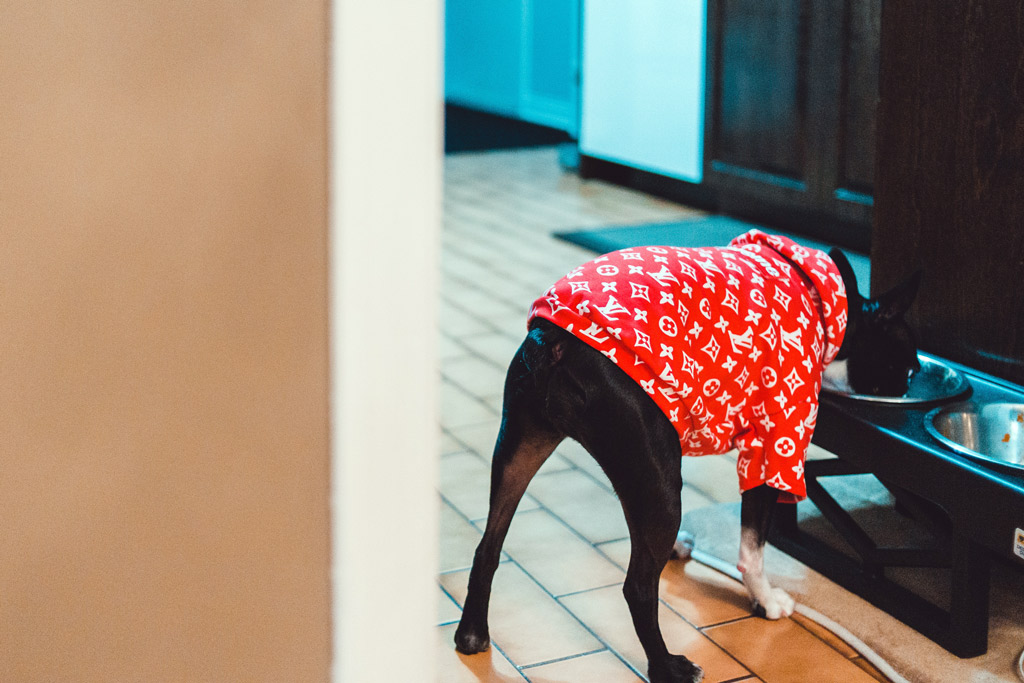
#3 – Boston Terrier Activities
Every dog needs both physical and mental stimulation to be optimally healthy and well-balanced. That’s why training, exercise, and playtime should be a part of your Boston Terrier’s care routine.
Plus, these activities benefit both you and your dog! 😉
One of the reasons is this…
Humans release oxytocin, also called the “love hormone,” when interacting with their dogs. This can be playing, cuddling, looking at each other, going for a walk, etc.
Studies show that:
- Oxytocin plays a role in bonding. When released, it has the effect of bonding you to the other person or dog involved.
- When oxytocin levels increase, cortisol levels decrease, i.e., your stress levels lower. This is a great health benefit!
So, here’s what you should know about training, exercising and playing with your Boston Terrier:
Boston Terrier Training
Training starts on day one, i.e., when your pooch enters your front door for the first time! Dogs are constantly learning, so make sure to be ready!
The first step towards training, which is usually skipped, is to understand your dog breed’s temperament.
This is the foundation for successful training. And during the training sessions, you will start discovering your pup’s own personality too!
Here are some characteristics about Boston Terriers:
- They are easy to train.
- They are considered to be intelligent.
- Some can be stubborn.
- They are eager to please their owners.
- This breed has a very high wanderlust potential.
- Bostons have high energy levels.
- And they are vigorous since they have very high-intensity levels (i.e., a short outburst of energy).
- They are very playful too.
Read also: Boston Terriers Personality – What’s It Like to Own One? and Are Boston Terriers Smart? Dog Intelligence vs Cognition.
Also, no matter your Boston Terrier’s age, all dogs need continuous training to keep their mind stimulated and to prevent unwanted behaviours mostly due to lack of training and boredom.
Since they are sensitive to punishment, reward-based training method works best for them.
Reward-based training is not only more successful than other training methods but also means you and your dog can work towards a positive relationship that will serve as a good foundation for future training.
This method consists of rewarding your dog’s good behaviour immediately after it happens: with praise, a caress or a healthy treat. The big takeaway of this method is that it encourages your dog to repeat good behaviour.
Reward-based training also involves generally ignoring any ‘unwanted’ behaviours. If dogs are not rewarded (i.e. receives no attention or treats) for a certain behaviour, then they tend to stop doing or repeating it.
Start by house-training your Boston Terrier, which will lay the foundation and also prepare your pooch for a lifetime of good behaviour.
Housebreaking (or house-training) consists of:
- Crate training: Boston Terrier Crate Training In 8 Steps.
- Potty training: Boston Terrier Potty Training In 6 Steps.
- Leash training: Boston Terrier Leash Training Without Pulling.
- Basic commands: Boston Terrier Obedience Training – Basic Commands.
- Socialization: Boston Terrier Socialization In 8 Steps.
Training should be fun. But it can easily become pretty overwhelming, especially if this is your first dog.
If you are having some trouble… I may be able to help with that. Click here to visit our Dog Training Essentials, where you will get a 3-part mini audio series + the everyday resource used by a well-known dog trainer.
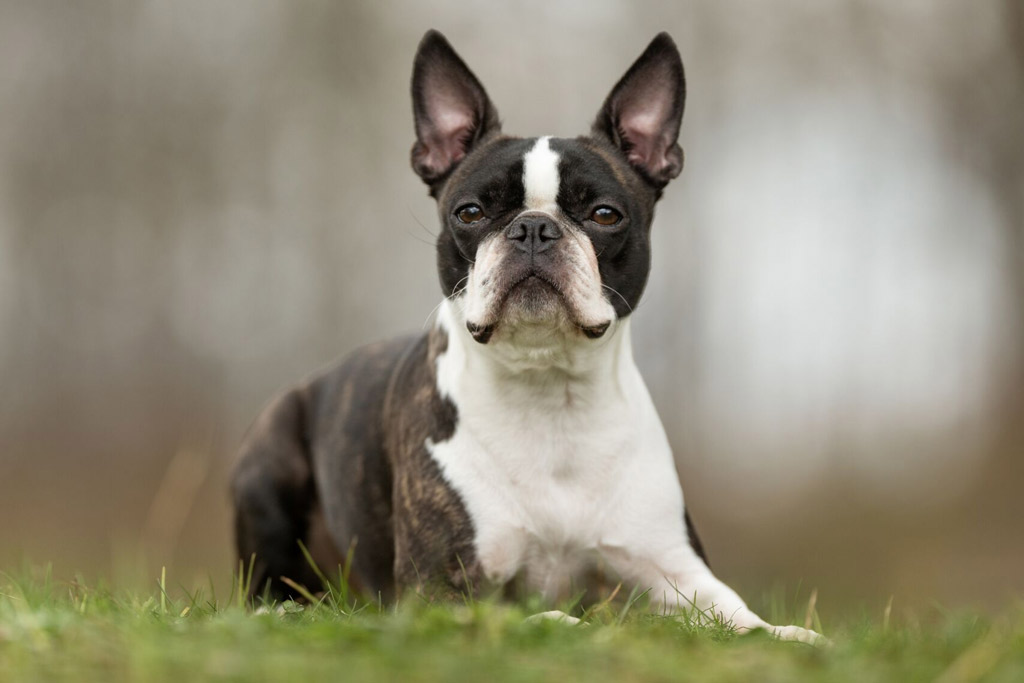
Boston Terrier Exercise
Beyond potty break walks, your Boston Terrier needs longer walks. These keep your pooch mentally and physically healthy.
Without enough exercise to stimulate their mind, most dogs become anxious or destructive (or both!)
According to VCA Animal Hospitals, the one-on-one time spent on walks can help deter attention-seeking behaviours like whining or barking. Plus, it’s a great way to bond with your dog.
Your Boston Terrier’s exercise needs depend on:
- Breed.
- Age.
- Energy levels.
Boston Terriers have high energy levels and adults require an hour of daily exercise, although some are happy to go longer.
Remember that Boston Terriers are a brachycephalic breed, so you need to be extra careful when exercising. This breed doesn’t tolerate well extreme temperatures, so they are prone to overheating during hot weather and suffering from frostbite during cold weather.
Also, due to their respiratory problems, avoid pulling on your dog’s collar.
What I recommend is using a harness (Amazon link) instead of a collar when exercising your Boston to prevent any injuries.
Read also: How Much Exercise Do Boston Terriers Need? Age-Specific for exercise needs according to age and safety tips when exercising this breed.
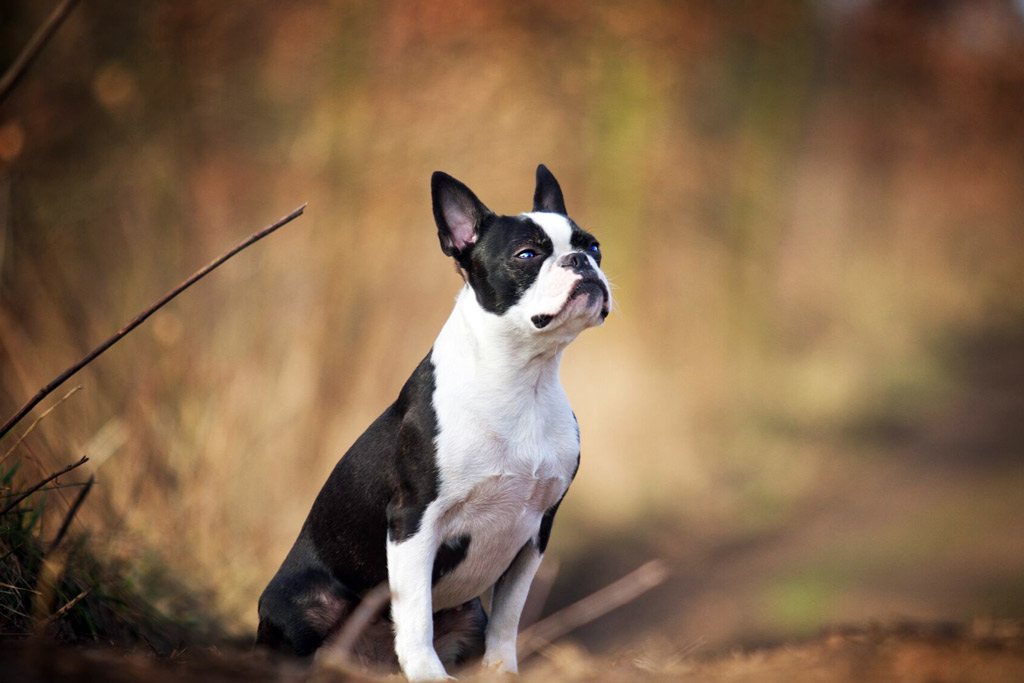
Boston Terrier Playtime
Boston Terriers are very playful. So, I encourage you to introduce some fun games into your dog’s daily routine.
Here’s a list of activities that can help your dog stay healthy and have fun:
- Fetch games for extra exercise (to tire out your pooch).
- Tug games when you are tired (playing whilst you are sitting down or taking on the phone).
- Treat-release toys for alone-time (to keep your Boston entertained when alone).
- Digging adventures with a sandbox (garden and indoor options available – check my toy guide!)
Keeping your Boston Terrier engaged and busy has never been easier! Check my favourite dog toys guide for some indoor and outdoor ideas.
Read also: What Are The Best Activities for Boston Terriers?

#4 – Boston Terrier Health
For your pooch’s optimal health, prevention is key.
This is where nutrition, exercise, grooming and a dog-friendly environment makes a difference in your dog’s life quality.
However, this doesn’t rule out the chances of your dog getting sick.
Plus, as with all dogs, the Boston Terrier is prone to certain health issues based on their breed.
Boston Terriers Health Problems
Bostons are a brachycephalic breed (flat-faced). They often have trouble breathing, are prone to overheating.
Here are the health problems related to this breed:
- Brachycephalic Syndrome: The three most common disorders include stenotic nares, everted laryngeal saccules and elongated soft palate.
- Patellar Luxation: An orthopaedic health issue.
- Hemivertebrae: This is a genetic disorder which affects many brachycephalic breeds that also have screw-tails.
- Sensorineural Deafness: They are prone to suffer from ear infections that can lead to sensorineural deafness.
- Cataracts: Especially affect senior dogs. Their eyes become cloudy; it can affect a dog’s vision quite dramatically if left untreated. It’s a hereditary condition but it can also develop if a dog suffers from diabetes.
- Corneal Ulcers: A painful eye condition.
- Glaucoma: An hereditary eye condition that typically shows when dogs are around 2 years old. It can cause total blindness, rapidly.
- Cherry Eye: This is a painful condition that affects a dog’s third eyelid.
- Distichiasis: Another eye disorder where too many eyelashes grow around a dog’s eyelid.
- Keratitis Sicca: Also known as Dry Eye. It happens when an ulcer damages the cornea of your dog’s eye.
- Entropion: Another eye condition where the eyelashes grow inwards.
Whilst growing up, Boston Terriers may need assistance with their ears standing up and can suffer from numerous eye conditions due to their prominent eyes, as listed above.
Since Boston Terriers are prone to having more health issues than other dog’s, I recommend having dog insurance like Petplan. Continue reading for more about this topic. 🙂
Read also: How Long Is a Boston Terriers Lifespan? How to Increase It.
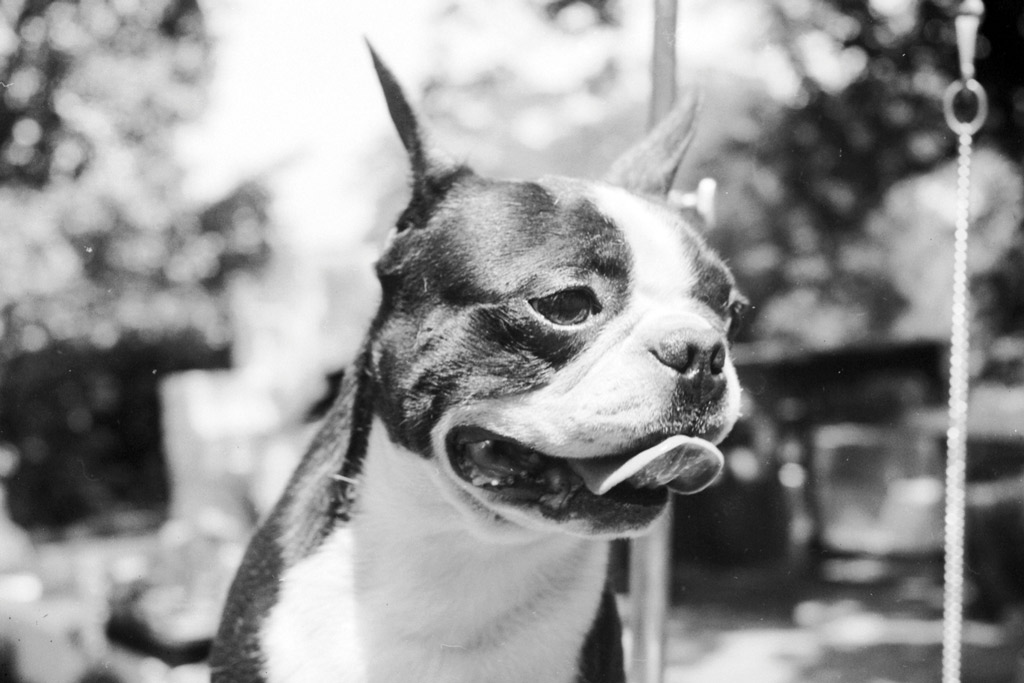
Prevent with Regular Check-ups at the Vet
Regular visit’s to your vet is a fundamental part of maintaining your Boston Terrier’s health and preventing further problems, thanks to an early diagnosis.
Insiders Tip: Visiting your vet before summer and early fall (before winter) starts is a good way to ensure that your Boston Terrier is healthy before the weather changes.
Also, annual check-ups are a great way to prevent any health issues, especially for seniors, and to monitor breed-related problems.
Regular check-ups also help to:
- Monitor breed-related problems listed above.
- Follow a vaccination schedule.
- Check on your Boston Terrier’s oral health to prevent any teeth problems.
- Keep an eye on current illness, if any.
Find a veterinarian that shares your values; it’s important to know which treatment approach you prefer for your pet.
In veterinary medicine, there are allopathic practitioners, holistic practitioners, and integrative practitioners.
- Allopathic veterinarians: They had a traditional western or conventional medical training. The general approach of allopathic vets is to treat symptoms of illness or disease with drugs and/or surgery. The primary focus is on treating existing symptoms.
- Holistic veterinarians: They have the same training as allopathic vets. However, they pursue additional training in alternative methods of healing, including herbs and nutritional supplements, chiropractic, acupuncture, homoeopathy, and nutrition and movement therapy. The focus of holistic veterinarians is to promote wellness and prevent health problems from developing.
- Integrative veterinarians: They combine the two approaches, both western and alternative medicine, to their treatment of patients. Also, both types of medicine have practical application in the care of pets.
Save Money with Pet Insurance
You’ll also want good insurance cover that will help with any unexpected expenses…
This is where Petplan Pet Insurance shines, as they give you the right cover you need without the worry of say settling a claim quickly or paying your vet directly. They try to make insuring your pet as easy as possible.
If you decide that pet insurance is out of the question, or out of your budget, I highly encourage you to set money aside for your pet’s expenses. Just like bringing your pup into your life, that’s a decision you’ll never regret!
Read also: What Is The Annual Cost of Owning a Boston Terrier?
Boston Terrier Parasite Prevention and Treatment
Dog parasites such as worm, fleas, ticks, mites and lice should be eliminated as soon as possible.
There are many commercial products for different parasite treatments. However, there are also natural parasite treatments and prevention tips that you can use.
Parasites cause high discomfort, including skin rashes and irritation, itchiness, fever, diarrhoea, etc.
Read also: Dog Parasite Prevention and Treatment – Worms, Fleas, Ticks blog post for a more insightful information.

Boston Terrier Health Checklist at Home
As part of maintaining your pup’s health routine, you can follow this checklist to complete a thorough examination of your dog, once a month. This way you could help pick up any early signs of illness or injury.
This dog health examination at home consists of checking your dog’s:
- Ears.
- Eyes.
- Nose.
- Mouth.
- Skin and coat.
- Paws and nails.
- Bones and joints.
- Bodyweight.
- Heart and lungs.
- Digestive system.
- Urinary system.
- And attitude.
Read also: Dog Health: The Ultimate Guide to Wellbeing and Longevity.
#5 – Boston Terrier Grooming
Grooming your Boston Terrier is not a difficult task after getting to know the basics.
It’s not mandatory to take your pooch to the groomers, especially if you rather do it yourself.
Boston Terriers are not a high maintenance dog breed when it comes to grooming. However, regular grooming will ensure your dog’s health and will keep infections at bay.
Plus, a grooming routine is a great exercise to gain your dog’s trust and build a strong bond with your pooch (rather than another chore). Reward your Boston’s patience constantly during a grooming session with affection and some treats!
The goal is to make grooming a positive, stress-free experience for both you and your pooch.
Here’s what grooming a Boston Terrier implies:
- Brushing your dog’s coat: How to Brush a Boston Terrier.
- Cleaning your dog’s ears: How to Clean a Boston Terrier’s Ears.
- Cleaning your dog’s eyes: How to Clean a Boston Terrier’s Eyes.
- Cleaning your dog’s wrinkles: How to Clean a Boston Terrier’s Nose Wrinkles.
- Bathing your dog: How to Bathe a Boston Terrier – and how often!
- Trimming your dog’s nails: How to Cut a Boston Terrier’s Nails.
- Brushing your dog’s teeth: How to Brush a Boston Terrier’s Teeth.
P.S. Here’s my Boston Terrier grooming shopping list for a happy and easy grooming routine!
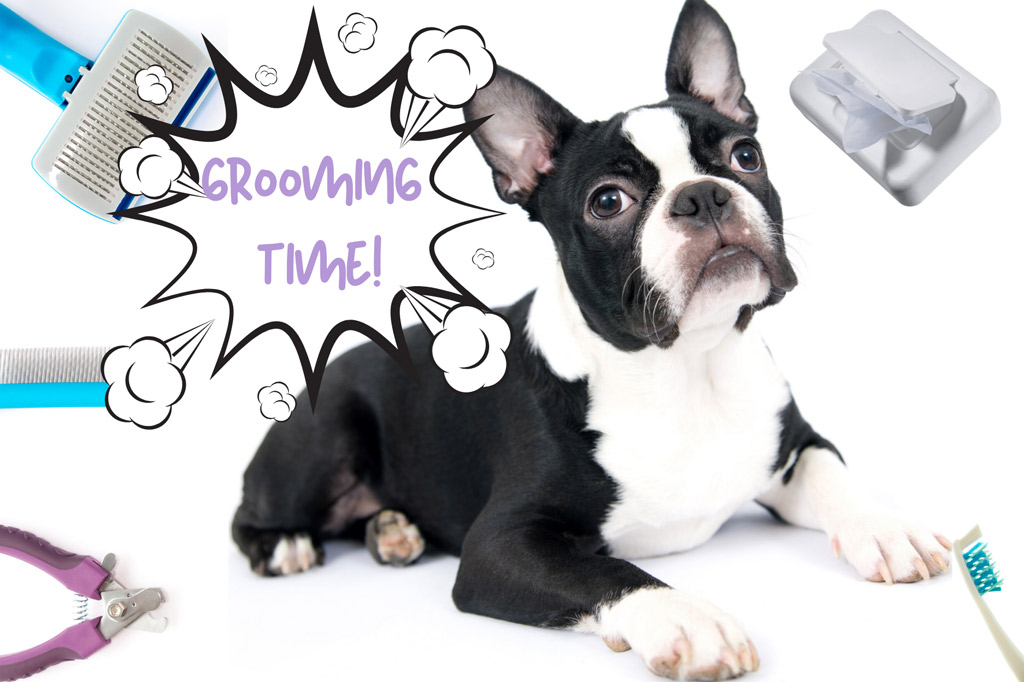
Boston Terrier Schedule
Dogs thrive on routine. The daily schedule helps your Boston Terrier to know what to expect and when. Also, it helps you to take better care of your pooch.
When planning to establish a dog schedule, here are the things you need to make time for on a daily basis (all related to the 5 steps for Boston Terrier care):
- Feeding times.
- Potty breaks.
- Dog walks.
- Playtime.
- Cuddle time.
- Training session.
- Grooming.
Once you establish a daily routine, remain consistent on both weekdays and weekends as much as possible, since dogs can find erratic changes in their schedule stressful.
Before jumping into an example of how your day could look like, your dog’s schedule will really depend on yours.
Ok, so…
For example, I have found that for a low-energy dog, a longer walk later in the morning works great to burn energy, which then leads to them having a nap in the afternoon when I might pop out and leave my dog at home.
If I can only fit one long walk in the morning, then I schedule playtime in the evening.
You can also decide on feeding times knowing when you could take your pooch to release himself.
